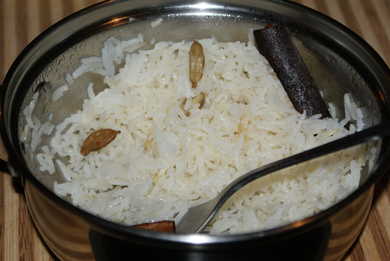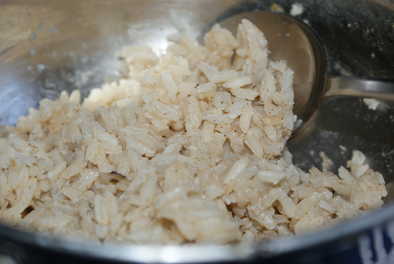
Incidentally - a good way to reheat cold rice if you have plenty of time but no microwave is to moisten it a little then pop it back into a very low oven in a pot with a tight-fitting lid for half an hour or so, by which time it will have gently steamed back to life.
Though I don't usually bother with the soaking, and so I use precisely twice the volume of water as rice for cooking.
The soaking details below are mostly based on Pat Chapman's New Curry Bible.
1 cup of rice weighs around 200g/7oz and will feed four small appetites, or 2 hogs.
To feed 4 average guests
Ingredients
- 300g/10oz Basmati rice - about 1½ cups
- 600ml/20 fl oz water - 2 cups
- 1 tablespoon ghee
- ½ teaspoon salt
Optional Spices:- 4 green cardamoms
- 4 cloves
- 2 inches cassia or cinnamon
- 2 bay leaves
- 1 teaspoon fennel seeds
- ½ teaspoon black cumin seeds
- 1 brown cardamom
- 2 star anise
- 20-30 strands saffron
Soak the rice in cold water for 10-20 minutes.
Rinse the rice until the water runs clear and drain.
Using a saucepan or a casserole with a tight-fitting lid twice the volume of the rice and heat the ghee.
Fry any seed spices you intend to flavour the rice in the ghee at this point.
Stir-fry the drained rice to coat the grains and heat them through.
Add exactly the specified volume of boiling water, add the salt (and saffron if using it) and stir well.
As soon as the water boils up, turn the heat down low and allow to cook for 6-10 minutes without opening the lid until all the water has been absorbed. You can turn off the heat when the surface water disappears, leaving little craters, which will be around 3 minutes for soaked rice, or 5-6 minutes for dry.
Now you can check the rice, if it's still hard, you can add more boiling water and simmer it down again and if it is softened but still al dente, give it a stir around with a fork and set it covered in a very low oven for half an hour or so for the grains to separate. The rice should be OK there for anything up to 1½ hours.
Also simmering, even over a low heat, becomes more-or-less impossible without burning the bottom (though baking in a low oven still works OK).
It might be worth thinking about moving to the boiling method below for such amounts.
When you get this right - you'll have the most fantastically light and fluffy rice.
Serves 4
Ingredients
- 225-350g (8-12oz) basmati rice
- 1.25-1.75 litres (2-3 pints) water
Pick through the rice to remove any grit and impurities.
Put the water in a saucepan and bring to the boil (it's not necessary to salt it).
Meanwhile, rinse the rice briskly with fresh cold water until most of the starch is washed off. Run boiling kettle water through the rice for its final rinse. Drain it, and add it immediately to the boiling water, put the lid on and start timing.
When the water returns to the boil, remove the lid and stir frequently. After 6 minutes, remove and taste a few grains. If the centre is no longer brittle, but has a good al dente bite to it, remove from the stove and drain, shaking off excess water. The rice should seem slightly undercooked.
Transfer the rice to a warmed serving dish and place it in a warming drawer or in a low oven for at least 30 minutes to dry and separate. Stir gently once during this time to aerate and loosen the rice.
He says: Regardless of measurements, you should use just enough water to cover the rice by about 2.5cm.
Incidentally, this seems to be the method recommended for cooking Thai Jasmine rice (but without adding any salt). Though I'd advise plenty of rinsing first, or it will be sticky as wallpaper paste. If it isn't anyway!
Serves 2
Ingredients
- a large cupful/200g white Basmati or Thai fragrant rice (if you are using Thai rice then expect a somewhat stickier result)
When you lift the lid, stir the rice with a fork. It should be dry and quite fluffy.
You can add pretty much anything you like to this simple rice: onions and tomatoes or passata in addition to the garlic would be typical.
You might think this is some regular rice, but you'd be mistaken.
This shit is awesome.
For rice.
Serves 4 as a main dish
Ingredients
- 2 cups long grain rice
- 1 teaspoon oregano fresh or dried
- ¼ teaspoon of cumin powder
- 3-4 cloves garlic, minced
- 4 tablespoons lard
- 4 cups strong chicken stock. Or pork. Pork is good too.
- 1 tsp salt
Peel and mince the garlic.
Heat the lard in heavy casserole dish that has a tight-fitting lid. Fry the rice, stirring, for about 5 minutes until it starts to crackle a little and the grains are well coated and begin to turn translucent.
Add dried oregano if using and stir, then the cumin powder and stir, then the chopped garlic and stir, then fresh oregano if using, then the salt, then add the stock and bring to a boil.
Cover and simmer until the stock has mostly been absorbed leaving little craters in the rice surface, then put the casserole in the oven. It can stay in here for 30 minutes or an hour until needed, by which time it should be dry and light.
If you're making it as part of a Mexican Meal, then using the broth from shredded chicken or posole is ideal.
Or at least, considerably more like long-grain Indian-style rice than my usual sushi rice.
For when you've run out of long grain rice.
Take your pick of spices...
Serves 4
Ingredients
- 1 cup sushi rice
- cardamoms, pierced
- cassia bark
- fenugreek seeds, or mustard seeds, or onion seeds, or cumin seeds, etc
- 2" ginger, grated
- 2 garlic cloves, crushed
- ghee or oil
- ½ tsp salt
- knob butter
Boil in a large quantity of water for about 6 minutes when the grains should be should be still firm but not hard, and then drain.
I also kept the rice water afterwards to use as a thin stock.
Waste not want not ;)
Fry the whole spices in ghee or oil, then add the ginger/garlic paste, and fry until the raw aroma has gone.
Add salt, any powdered spices you might fancy, I used none, but I did add the tomato seeds from those de-seeded tomatoes, a little extra butter and stir in the drained rice.

Madhur Jaffrey also specifies 1⅓ times the volume of water to damp rice.
Some Chinese cooks advise adding water to cover their (Jasmin) rice in the pan to the depth of their first finger joint. Though since both the length of fingers and the shape of pans varies that seems entirely arbitrary. I suppose at least it will give you a visual check.
One caveat - if you're making a really big pot of rice I'd be inclined to use slightly more water (say 1½ times) since it seems more difficult to get it to cook through.